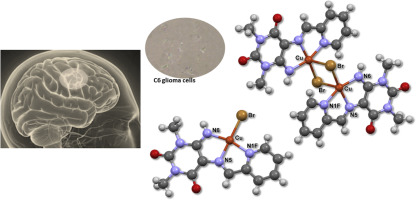当前位置:
X-MOL 学术
›
J. Inorg. Biochem.
›
论文详情
Our official English website, www.x-mol.net, welcomes your feedback! (Note: you will need to create a separate account there.)
Relationship between the antiproliferative properties of Cu(II) complexes with the Schiff base derived from pyridine-2-carboxaldehyde and 5,6-diamino-1,3-dimethyluracil and the redox status mediated by antioxidant defense systems on glioma tumoral cells.
Journal of Inorganic Biochemistry ( IF 3.9 ) Pub Date : 2020-03-06 , DOI: 10.1016/j.jinorgbio.2020.111053 Nuria A Illán-Cabeza 1 , Sonia B Jiménez-Pulido 1 , Francisco Hueso-Ureña 1 , María J Ramírez-Expósito 2 , José M Martínez-Martos 2 , Miguel N Moreno-Carretero 1
Journal of Inorganic Biochemistry ( IF 3.9 ) Pub Date : 2020-03-06 , DOI: 10.1016/j.jinorgbio.2020.111053 Nuria A Illán-Cabeza 1 , Sonia B Jiménez-Pulido 1 , Francisco Hueso-Ureña 1 , María J Ramírez-Expósito 2 , José M Martínez-Martos 2 , Miguel N Moreno-Carretero 1
Affiliation

|
A set of new copper(II) complexes containing the Schiff base ligand derived from pyridine-2-carboxaldehyde and 5,6-diamino-1,3-dimethyluracil (6-amino-1,3-dimethyl-5-[(pyridin-2-ylmethylidene)-amino]-pyrimidine-2,4(1H,3H)-dione) with several anions (Cl-, Br-, I-, ClO4-, NO3-) and, two of them with 1,10-phenanthroline, were synthesized and characterized by means of elemental analysis, FT-IR, and single-crystal X-ray diffraction methods. Their ability to act as antitumor agents against C6 glioma cells has been also explored. These complexes contain copper a redox active metal essential for the regulation of cellular pathways that are fundamental for brain function. The antiproliferative activity of the complexes and their effect on cell cycle, apoptosis profile, bioenergetic behavior, intracellular reactive oxygen species (ROS) production, autophagy and enzyme antioxidant defense systems (superoxide dismutase (SOD), catalase (CAT) and glutathione peroxidase (GPx) activities) were analyzed in C6 glioma cells. Although the compounds show limited antiproliferative activity, they are able to modify S-phase of cell cycle and induce G2/M phase arrest. Also, copper(II) complexes promote apoptosis and, in a lesser extent, autophagy, being both processes modulated by ROS generation, due to their property to affect the enzyme antioxidant defense systems, mainly SOD and CAT but not GPx.
中文翻译:

铜(II)配合物与吡啶-2-羧醛和5,6-二氨基-1,3-二甲基尿嘧啶的席夫碱的抗增殖特性与胶质瘤肿瘤细胞上抗氧化防御系统介导的氧化还原状态之间的关系。
一组新的铜(II)配合物,包含衍生自吡啶-2-羧醛和5,6-二氨基-1,3-二甲基尿嘧啶(6-氨基-1,3-二甲基-5-[(吡啶- 2-基亚甲基)-氨基]-嘧啶-2,4(1H,3H)-二酮)与几个阴离子(Cl-,Br-,I-,ClO4-,NO3-),其中两个与1,10-菲咯啉是通过元素分析,FT-IR和单晶X射线衍射方法合成和表征的。还已经研究了它们充当针对C6神经胶质瘤细胞的抗肿瘤剂的能力。这些络合物包含铜和氧化还原活性金属,对调节大脑功能至关重要的细胞途径至关重要。复合物的抗增殖活性及其对细胞周期,凋亡概况,生物能行为,细胞内活性氧(ROS)产生的影响,在C6胶质瘤细胞中分析了自噬和酶抗氧化防御系统(超氧化物歧化酶(SOD),过氧化氢酶(CAT)和谷胱甘肽过氧化物酶(GPx)的活性)。尽管这些化合物显示出有限的抗增殖活性,但它们能够修饰细胞周期的S期并诱导G2 / M期停滞。同样,铜(II)配合物由于其影响酶抗氧化剂防御系统(主要是SOD和CAT,但不影响GPx)的特性,可促进细胞凋亡,并在较小程度上促进自噬,这两个过程均受ROS产生的调节。
更新日期:2020-03-06
中文翻译:

铜(II)配合物与吡啶-2-羧醛和5,6-二氨基-1,3-二甲基尿嘧啶的席夫碱的抗增殖特性与胶质瘤肿瘤细胞上抗氧化防御系统介导的氧化还原状态之间的关系。
一组新的铜(II)配合物,包含衍生自吡啶-2-羧醛和5,6-二氨基-1,3-二甲基尿嘧啶(6-氨基-1,3-二甲基-5-[(吡啶- 2-基亚甲基)-氨基]-嘧啶-2,4(1H,3H)-二酮)与几个阴离子(Cl-,Br-,I-,ClO4-,NO3-),其中两个与1,10-菲咯啉是通过元素分析,FT-IR和单晶X射线衍射方法合成和表征的。还已经研究了它们充当针对C6神经胶质瘤细胞的抗肿瘤剂的能力。这些络合物包含铜和氧化还原活性金属,对调节大脑功能至关重要的细胞途径至关重要。复合物的抗增殖活性及其对细胞周期,凋亡概况,生物能行为,细胞内活性氧(ROS)产生的影响,在C6胶质瘤细胞中分析了自噬和酶抗氧化防御系统(超氧化物歧化酶(SOD),过氧化氢酶(CAT)和谷胱甘肽过氧化物酶(GPx)的活性)。尽管这些化合物显示出有限的抗增殖活性,但它们能够修饰细胞周期的S期并诱导G2 / M期停滞。同样,铜(II)配合物由于其影响酶抗氧化剂防御系统(主要是SOD和CAT,但不影响GPx)的特性,可促进细胞凋亡,并在较小程度上促进自噬,这两个过程均受ROS产生的调节。


























 京公网安备 11010802027423号
京公网安备 11010802027423号